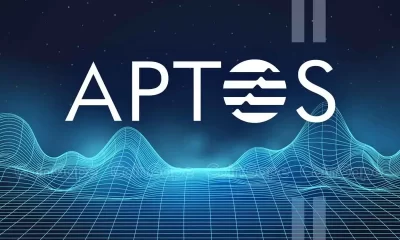Technology
Roundhill Investment Wants to Launch an ETF Focused on Humanoid Robots
Published
5 days agoon
By
admin

Betting on the future of human-like machines, New York-based Roundhill Investments filed a prospectus with the U.S. Securities and Exchange Commission to launch a Humanoid Robotics ETF.
If approved, the fund would expose investors to companies at the forefront of humanoid robotics, a rapidly evolving area of artificial intelligence.
Humanoid robotics refers to robots that resemble and function similarly to humans. These robots typically have a human-like structure, including a head, torso, arms, and legs. Examples of humanoid robots include Tesla’s Optimus, and Boston Dynamics Atlas robots.
According to the filing, the Humanoid Robotics Fund would invest primarily in equity securities of companies that Roundhill considers leaders in humanoid robotics—either by having developed fully functional commercial robots, moving toward commercial production, or supplying essential technologies used in their development.
“Under normal circumstances, the Fund invests at least 80% of its net assets plus borrowings for investment purposes in Humanoid Robotics Companies,” the prospectus said.
Roundhill, founded in 2018, is known for thematic ETFs. The Humanoid Robotics ETF would join its lineup of niche tech funds, including those focused on generative AI, the metaverse, video games, and Bitcoin and Ethereum-covered Strategy ETFs. The firm did not specify which exchange the new ETF would trade on.
The company did not respond to a request for comment.
While several ETFs focus on robotics and AI are on the market, including the Global X Robotics & Artificial Intelligence ETF (BOTZ) and the ROBO Global Robotics & Automation Index ETF (ROBO), none are currently dedicated solely to humanoid robots.
Roundhill acknowledged several risk factors in the prospectus, including limited commercial availability, operational or staffing challenges, global and regulatory pressures, AI and robotics development in China, and a high risk of product obsolescence as the industry progresses.
“The development and commercialization of fully-functional humanoid robots involve complex and evolving technologies, which may face unforeseen technical challenges, regulatory hurdles, and market acceptance issues,” the prospectus said. “As a result, investments in Humanoid Robotics Companies may be subject to higher levels of risk and volatility.”
The Roundhill Humanoid Robotics ETF arrives amid a surge in interest in general-purpose robotics as companies like Tesla, Nvidia, OpenMind, Boston Dynamics, and Figure AI race to bring humanoid machines to market.
In 2023, the global humanoid robotics market was valued at $2.21 billion, according to market research company S & S Insider, that number is expected to surpass $76 billion by 2032.
Editor’s note: This story was corrected to note that the prospectus has indeed been filed with the SEC.
Generally Intelligent Newsletter
A weekly AI journey narrated by Gen, a generative AI model.
Source link
You may like


Apple Delists 14 Crypto Apps in South Korea Including KuCoin and MEXC Exchanges Amid Regulatory Crackdown


Athens Exchange Group eyes first onchain order book via Sui


Futureverse Acquires Candy Digital, Taps DC Comics and Netflix IP to Boost Metaverse Strategy


Court Grants Ripple And SEC’s Joint Motion To Suspend Appeal


AVAX Falls 2.1% as Nearly All Assets Trade Lower


What is a VTuber, and how do you become one in 2025?


Disclosure: The views and opinions expressed here belong solely to the author and do not represent the views and opinions of crypto.news’ editorial.
Chinese companies are leading the AI arms race. Chinese politician and computer scientist Lou Qinjian said as much, recently commending DeepSeek for their accomplishments: “DeepSeek adheres to an open-source approach and promotes the widespread application of AI technology globally, which contributes Chinese wisdom to the world,” he said.
“Through the rise of companies like DeepSeek, we can see the innovation and inclusiveness of China’s technological development.”
In February, at the Artificial Intelligence Action Summit in Paris, US Vice President JD Vance made clear where the Trump Administration stands on artificial intelligence. He said that, first and foremost, the Trump administration will ensure that American AI technology remains “the gold standard” worldwide and that US companies remain the partner of choice for international companies and foreign countries.
The Vice President argued that excessive regulation in the AI sector would kill the nascent industry, and that the administration would encourage pro-AI growth policies. “And I’d like to see that deregulatory flavor, making its way into a lot of the conversations at this conference,” he said. Vance also made it clear that AI should be free of ideological bias and that “American AI will not be co-opted into a tool for authoritarian censorship.”
Finally, the Trump administration will safeguard a pro-worker growth path for AI so it can create jobs in the United States. Vance also brought up the notion of foreign adversaries weaponizing AI software to rewrite history, surveil users, and censorship. As Vance stated:
“This is hardly new, of course, as they do with other tech. Some authoritarian regimes have stolen and used AI to strengthen their military intelligence and surveillance capabilities, capture personal data, and create propaganda to undermine other nations’ national security.”
He warned conference attendees against partnering with such regimes. “From CCTV to 5G equipment, we’re all familiar with cheap tech in the marketplace that’s been heavily subsidized and exported by authoritarian regimes,” he said. “But as I know, and I think some of us in this room have learned from experience, partnering with them means chaining your nation to an authoritarian master that seeks to infiltrate, dig in, and seize your information infrastructure.”
Under the hood of DeepSeek
DeepSeek shocked global markets in January with low-cost models that made it seem like US companies were now behind in the AI arms race. The AI lowered the costs of developing reliable AIs, proving itself to be a powerful and cost-efficient open-source language model.
It changed the way we view how much capital and computational resources are needed to develop AI. Researchers across the Western world are now left playing catch-up, studying DeepSeek’s technical advances and social implications.
There are clear benefits to DeepSeek. For instance, startups without the deep pockets of Google and OpenAI can now compete in the AI sector. AI models can do more with less in the post-DeekSeep world. The company claims it took a mere $6 million using 2,000 Nvidia H800 graphics processing units (GPUs) versus the $80 million to $100 million cost of GPT-4 and the 16,000 H100 GPUs needed for Meta’s LLaMA 3.
The Hangzhou-based startup’s AI model employs reasoning capabilities that allow smaller models, whereas other AIs have had to employ larger models. It also uses reinforcement learning, eliminating the need for supervised fine-tuning. Moreover, DeepSeek’s multi-head latent attention (MHLA) mechanism decreases memory usage to 5%, down from 13%, in earlier AI methods.
DeepSeek raises privacy concerns and questions regarding data-sourcing and copyright. DeepSeek is open-weighted, not open source. Open source models share the full source code and data, and open weight models share trained weights but not the code. Therefore, the exact source code used to train the models is not available.
Due to DeepSeek’s open weight model, it is unknown what its sources are. This seems to be the way most AI companies operate. DeepSeek made public its R1 training and open weight models, which will allow other AI developers to copy and build on the model, but not its sources.
DeepSeek and geopolitics
A race for AI dominance between China and the US has come into focus, while Russian capabilities on the matter remain a secret. Sberbank—Russia’s largest state-owned bank—has revealed its intentions to collaborate with Chinese researchers on AI projects. Russia and China, which share what they call a “no limits” strategic partnership, have long talked about AI cooperation—including in military applications—but little is publicly known about its depth or scope.
Sberbank, under CEO German Gref, once a Soviet-style former state savings bank burdened by onerous bureaucracy, is today one of Russia’s leading players in artificial intelligence. It released its GigaChat model in 2023. “Sberbank has many scientists. Through them, we plan to conduct joint research projects with researchers from China,” Sberbank First Deputy CEO Alexander Vedyakhin told Reuters.
As the AI arms race heats up, the benefits of open source innovation come to the forefront. Little flowers bursting through the concrete all around the world, coming up with cool tech that is open-sourced and decentralized.
Manouk Termaaten
Manouk Termaaten is the founder and CEO of Vertical Studio AI.
Source link
Blockchain
Web3 search engine can reshape the internet’s future
Published
6 days agoon
April 10, 2025By
admin
Disclosure: The views and opinions expressed here belong solely to the author and do not represent the views and opinions of crypto.news’ editorial.
The internet is at a crossroads. People are continuing to express their frustration and dissatisfaction with the internet—double that of what they felt 20 years ago—as centralized platforms are facing increasing scrutiny for their opaque algorithms, data exploitation, and bias in content curation.
Most online platforms today run on web2, where FAANG companies—Meta, formerly known as Facebook, Amazon, Apple, Netflix, and Alphabet, formerly known as Google—control the data, serve ads, and track users for profit. Users are ultimately the product, and while these companies have added billions in market cap by turning users into the product, this is far from the best model for creating a sustainable knowledge engine like the internet. Participants in the internet ecosystem are starting to wake up to the fact that this model doesn’t really work for anyone except those FAANG companies.
Nowhere are these problems more evident than in search. Search is one of the most fundamental activities on the internet and, thus, stands at the forefront of “gatekept content.” If the internet really is our collective knowledge engine, then search is the first step in acquiring that knowledge.
It is sometimes even the last and only step in using the internet to acquire knowledge, considering that the first result on a Google page has a clickthrough rate of over 25 percent and the tenth result, proportionately, only has a tenth of that. Presumably, a fraction of that fraction even makes it to the second page of results.
Now, consider Google’s prominent position in all of search. Even while Google’s search market share last year dropped below 90 percent for the first time in 10 years, it is still within the range of the popular vote total for a third-world dictator. So, the One True Result that has been served up by Google’s algorithm is getting a quarter of the traffic for the search engine that still holds somewhere in the area of 90 percent of the search engine market share. That’s a lot of opaque and centralized power centered in one private company.
Even while competitors like DuckDuckGo and Bing try to carve out some of their own market share by offering AI-powered search or increased privacy, as centralized companies, they fundamentally present the same problem Google does, without the market share. The integrity of our search results has never been more crucial, and we can’t leave it to web2 structures to be good custodians of that integrity, especially when the priorities of those structures to protect their users can turn on a dime.
The solution is here: Enter web3
How do we put how information is organized back into the hands of users, especially as the search engines promise to become even more inscrutable with the implementation of AI and the obscuring of sources?
One possible way to put that power back into the hands of users is what has thus far been built with web3. Web3 can allow us to build a decentralized, community-powered search engine while participating in a truly open and trustless search ecosystem. A decentralized node-powered ecosystem can ensure fair, unbiased, and censorship-resistant search results, free from the corporate agendas that have shaped traditional search engines.
Instead of relying on corporations, web3 platforms are permissionless, sovereign, and decentralized. They are powered by blockchain and smart contracts instead of centralized corporate servers that open users to vulnerabilities and data insecurity. Web3 gives users control back over their data, identity, and digital assets.
There are a host of other ways in which web3 can empower the user. These include self-sovereignty, permissionless control of assets without fear of confiscation, self-custodial staking and earning, access for the unbanked, peer-to-peer transfers, and, perhaps most important of all, that fundamental decentralization, which eliminates single points of failure while being resistant to manipulation.
There is also no behavioral profiling, no centralized control, and no data tracking. This means no censorship risk, no suppression of competing voices, and a search experience that respects user privacy.
Users must work to reclaim power
Search engines today function as gatekeepers of information, with centralized platforms deciding which content is amplified, suppressed, or monetized based on user profiles and corporate interests. Users deserve a fairer and ultimately better search experience, one where ranking algorithms are not influenced by personal data, past behavior or profit-driven agendas.
The problem is bound to get worse as the AI race heats up and companies look for new data sources on which to train these AIs. Whatever promises a centralized company might have once made to the user about not tracking or using data, again, these priorities can shift very quickly in something like an AI technology realignment. The beauty of web3 is that the structure of the technology itself prevents such exploitation.
Web3 may seem abstract right now, but it’s not all that different from the kind of technical fluency users needed to acquire as they went from the personal computer to the networked personal computer of web2. Users essentially just have to trade out an encrypted password shared with a central web service (and who knows where else) for an encrypted wallet that only they can control and access. The benefits of full control over assets and data will far outweigh whatever stumbling blocks there are to this learning curve.
Users have shown that they are willing to trade a lot for convenience, but perhaps they’ve reached a breaking point in that bargain. Now is the time for web3 to take advantage.

Timothy Enneking
Timothy Enneking is the CEO of Presearch, a decentralized, privacy-focused, web3 search engine. He was initially invited to join the project seven years ago after he recommended it during a CNBC Asia interview on crypto, and he remained an advisor for four years. He rejoined Presearch in August 2023 when the founder invited him to become the CEO and bring the project to the next level. He is the founder and Principal of Digital Capital Management, LLC (“DCM”), which runs CAF 2017, a crypto trading fund. He is also the founder and managing partner of Psalion, which manages two venture capital funds and a yield farming operation. For nine years ending in June 2024, Mr. Enneking was the Chief Investment Officer of Mana Companies Asset Management, a medium-sized family office (which did not invest in crypto). Prior to those activities, Mr. Enneking founded and managed Tera Capital Fund, a fund of funds focused on Eastern Europe (established in 2004). Simultaneously, in 2013, he was engaged to manage the world’s first Bitcoin fund. Mr. Enneking also has extensive M&A experience, having completed more than 70 transactions with an aggregate transaction value of over US$12 billion. He speaks near-native French and Russian, as well as German. He has five university degrees, all in international business and law.
Source link

Disclosure: The views and opinions expressed here belong solely to the author and do not represent the views and opinions of crypto.news’ editorial.
AI-generated avatars and virtual assistants will revolutionize our digital landscape, powering virtual influencers, workplace stand-ins, and immersive metaverse experiences. Yet, beneath this technological marvel lies a pressing question: who truly owns and controls your digital identity? The reality is stark—most AI avatars are tethered to centralized platforms where corporations hold dominion, exposing users to exploitation, financial fraud, and a profound loss of autonomy. As these digital personas become integral to our virtual lives, the need for a transformative solution has never been more urgent.
Decentralizing AI avatars through blockchain technology and smart contracts emerges as a vital antidote, promising to restore control to individuals in an increasingly virtualized world. The dangers of centralized systems are vividly demonstrated by high-profile abuses that have shaken public trust. In January 2024, a deepfake robocall mimicking U.S. President Joe Biden targeted New Hampshire voters, falsely urging Democrats to skip the primary in a bid to sway the 2024 election. This brazen act of manipulation, which prompted an FCC ruling to ban deepfake robocalls and ignited debates over AI regulation, exposed the fragility of centralized platforms that harbor the data fueling such scams.
The entertainment industry offers another stark warning. In early 2024, explicit deepfake images of Taylor Swift flooded social media, amassing over 45 million views before removal after a 17-hour delay. This incident laid bare the limitations of centralized content moderation, which often falters under pressure, leaving women and public figures disproportionately vulnerable to digital harm. The fallout was swift—Swift’s team condemned the breach, and platforms scrambled to respond, yet the delay highlighted a systemic failure to protect digital likenesses in real-time.
Additionally, Meta’s Oversight Board recently took up cases involving deepfake explicit imageries, noting inconsistent moderation practices— certain content was removed faster than others due to not passing specific community guidelines, highlighting inequities in centralized systems. These examples show how centralized avatar management leaves users powerless and unable to prevent misuse of their digital likeness.
Why AI avatars need to be decentralized
Centralized platforms trap users in ecosystems where their digital identities are subject to exploitation or sudden deactivation at corporate whim. This unchecked dominance shatters the vision of a user-empowered digital future, reducing individuals to mere cogs in a profit-driven machine. Decentralization flips this narrative, fostering self-sovereign identity where users hold the reins, owning and managing their avatars with confidence.
By placing control in the hands of individuals, decentralized systems can curb corporate overreach, ensuring AI avatars reflect their creators’ intent rather than serve as tools for exploitation.
Blockchain-powered AI ownership
Blockchain technology stands as a beacon of hope against these escalating threats. Through on-chain verification, it forges an unalterable record of avatar ownership, forging a secure bond between digital identities and their rightful owners while decisively countering unauthorized deepfake abuse.
This was painfully evident in February 2023, when a French interior designer fell pray in a romance scam: fraudsters wielded AI-generated images and messages to impersonate Brad Pitt, spinning a tale of a fabricated relationship and a fabricated cancer diagnosis that convinced her to part with €830,000—her life savings—before the deception unraveled. Such episodes unveil the dangers of centralized platforms, which hoard user data and become fertile ground for AI-driven fraud, eroding trust and inflicting devastating personal losses. Without a verifiable system to authenticate digital identities, AI-driven deception will only intensify. Users are left defenseless as deepfakes become more sophisticated and harder to detect. The challenge is clear: How can we secure digital avatars against misuse while ensuring individuals, not corporations, maintain control over their online presence?
Yet, blockchain’s potential extends further. Smart contracts bolster this framework by automating rights management, guaranteeing avatars operate with unwavering security and transparency while fortifying defenses against fraud. This comprehensive approach not only shields digital assets from theft but also alleviates the ethical and legal burdens intensified by centralized oversight, equipping users with verifiable dominion over their virtual selves.
A web3 future for AI avatars
Decentralized AI avatars can also drive a vibrant web3 economy, integrating into metaverses, digital workspaces, and decentralized social networks. These avatars can become dynamic assets—representing users in virtual worlds, facilitating remote collaboration, or enabling secure interactions online. Picture a musician selling a unique avatar on a decentralized marketplace or a professional using a blockchain-verified digital twin to authenticate their presence in a virtual meeting. This ecosystem thrives on user ownership, positioning decentralized AI avatars as a foundation for the next digital economy.
The drive to decentralize AI avatars is non-negotiable—centralized systems, exposed by explosive deepfake scandals and crumbling moderation, threaten to dismantle safety and freedom in an AI-drenched world. Blockchain carves a decisive path to empowerment, handing the reins of digital identity back to individuals, not corporate overlords. The clock is ticking: seize control of your digital destiny now, or watch it vanish into a dystopian abyss of corporate domination.

Roman Cyganov
Roman Cyganov is the founder and CEO of Antix, a company at the forefront of web3, AI, and gaming technologies. Recognized by OUTPUT as one of the Top 10 Global Talents, Roman has a rich history of driving technological innovation and redefining how businesses engage with digital audiences. Under his leadership, Antix has developed AIGE, a cutting-edge technology that crafts hyper-realistic AI-powered digital humans, revolutionizing client interactions in the digital space. Roman’s entrepreneurial journey includes co-founding VIVIX Inc., where he served as CCO before his pivotal role at Antix. His career is marked by a successful exit and numerous high-profile ventures that underscore his role as a serial entrepreneur leading the next wave of digital transformation.
Source link

Apple Delists 14 Crypto Apps in South Korea Including KuCoin and MEXC Exchanges Amid Regulatory Crackdown

Athens Exchange Group eyes first onchain order book via Sui

Futureverse Acquires Candy Digital, Taps DC Comics and Netflix IP to Boost Metaverse Strategy
Court Grants Ripple And SEC’s Joint Motion To Suspend Appeal

AVAX Falls 2.1% as Nearly All Assets Trade Lower

What is a VTuber, and how do you become one in 2025?

Top Expert’s Update Sets $10 Target

How Academia Interacts With The Bitcoin Ecosystem

AB DAO and Bitget Launch Dual Reward Campaign, Distributing $2.6M Worth of $AB Globally

AI crypto tokens at risk as Nvidia faces restrictions on China exports

Coinbase Urges Australia to Vote for Crypto Progress in May

How High Would Pi Network Price Go If Pi Coin Adopts Transparency to Avoid Mantra Pitfalls

XRP’s ‘Rising Wedge’ Breakdown Puts Focus on $1.6 Price Support

China selling seized crypto to top up coffers as economy slows: Report

Ethereum Price Dips Again—Time to Panic or Opportunity to Buy?

Arthur Hayes, Murad’s Prediction For Meme Coins, AI & DeFi Coins For 2025

Expert Sees Bitcoin Dipping To $50K While Bullish Signs Persist

Aptos Leverages Chainlink To Enhance Scalability and Data Access

Bitcoin Could Rally to $80,000 on the Eve of US Elections

Crypto’s Big Trump Gamble Is Risky

Sonic Now ‘Golden Standard’ of Layer-2s After Scaling Transactions to 16,000+ per Second, Says Andre Cronje

Institutional Investors Go All In on Crypto as 57% Plan to Boost Allocations as Bull Run Heats Up, Sygnum Survey Reveals

Ripple-SEC Case Ends, But These 3 Rivals Could Jump 500x

3 Voting Polls Show Why Ripple’s XRP Price Could Hit $10 Soon

Has The Bitcoin Price Already Peaked?

A16z-backed Espresso announces mainnet launch of core product

The Future of Bitcoin: Scaling, Institutional Adoption, and Strategic Reserves with Rich Rines

Xmas Altcoin Rally Insights by BNM Agent I

Blockchain groups challenge new broker reporting rule

I’m Grateful for Trump’s Embrace of Bitcoin
Trending

 24/7 Cryptocurrency News5 months ago
24/7 Cryptocurrency News5 months agoArthur Hayes, Murad’s Prediction For Meme Coins, AI & DeFi Coins For 2025

 Bitcoin3 months ago
Bitcoin3 months agoExpert Sees Bitcoin Dipping To $50K While Bullish Signs Persist

 24/7 Cryptocurrency News3 months ago
24/7 Cryptocurrency News3 months agoAptos Leverages Chainlink To Enhance Scalability and Data Access

 Bitcoin5 months ago
Bitcoin5 months agoBitcoin Could Rally to $80,000 on the Eve of US Elections

 Opinion5 months ago
Opinion5 months agoCrypto’s Big Trump Gamble Is Risky

 Altcoins3 months ago
Altcoins3 months agoSonic Now ‘Golden Standard’ of Layer-2s After Scaling Transactions to 16,000+ per Second, Says Andre Cronje

 Bitcoin5 months ago
Bitcoin5 months agoInstitutional Investors Go All In on Crypto as 57% Plan to Boost Allocations as Bull Run Heats Up, Sygnum Survey Reveals

 Price analysis5 months ago
Price analysis5 months agoRipple-SEC Case Ends, But These 3 Rivals Could Jump 500x


